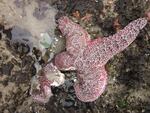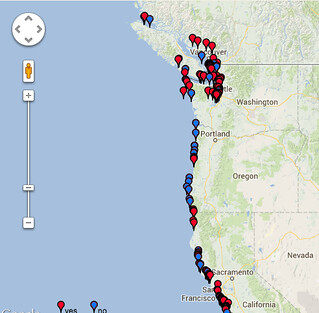
The leg of this purple ochre sea star in Oregon is disintegrating, as it dies from sea star wasting syndrome.
Photo by Elizabeth Cerny-Chipman, courtesy of Oregon State University
A common species of sea star faces possible extinction along parts of the Oregon Coast because of a mysterious wasting syndrome that was scarcely present in the state's marine waters two months ago.
Sea star wasting syndrome has been ravaging the marine creature's population on much of the West Coast for months — particularly in the waters of Puget Sound, British Columbia and California.
The first reports of the disease among Oregon sea stars — more commonly called star fish — came out in May. Now, according to Oregon State University, an estimated 30 to 50 percent of the Oregon populations of the ochre sea star species in the intertidal zone have the disease.
Researchers at Oregon State University have been monitoring the event. They say this species may be headed toward localized extinction in Oregon.
Click for interactive map. Credit: data.piscoweb.org
“This is an unprecedented event,” said Bruce Menge, a marine biology professor at OSU. “We’ve never seen anything of this magnitude before."
Menge said researchers still have much to learn about the outbreak.
“We have no clue what’s causing this epidemic, how severe the damage might be or how long that damage might last,” he said. “It’s very serious.”
Sea stars infected with the disease physically deteriorate before they die. In some cases, afflicted arms break off from the sea star's body and walk away before dissolving completely. Scientists suspect a bacteria or virus is causing it, but they don't know for sure. Until about six weeks ago, there had only been a few cases reported in Oregon.
Watch a KCTS9/EarthFix video on the Puget Sound sea star die-off
Researchers say they've been shocked at the rapid spread of the disease that had seemingly passed over Oregon. In intertidal zones of the Oregon Coast, less than 1 percent of the ochre sea stars were affected in April, and only slightly more than that by mid-May. That stood in contrast to the rest of the West Coast.
“It wasn’t clear why those areas had been hit and Oregon had not,” said OSU's Kristen Milligan. “We were hoping that Oregon’s coast would be spared. Although it was hit late, we are obviously being hit hard by this potentially devastating syndrome.”
Milligan is program coordinator at OSU for the Partnership for Interdisciplinary Studies of Coastal Oceans, or PISCO, which is a collaboration of OSU, the University of California/Santa Cruz, UC/Santa Barbara and Stanford University.
The sea star is considered a “keystone” predator, so its loss could disrupt the entire marine intertidal ecosystem. They attack mussels and keep their populations under control. Absent enough sea stars, mussel populations can explode, covering up algae and other small invertebrates. Some affected sea stars also eat sea urchins.
"Sea stars are an incredibly important species in the food chain of our coastal habitats,” Milligan said. “If sea stars are absent in these very highly biodiverse reef areas, these ecological communities will change.”
That change could include an increased numbers of sea urchins that can overgraze kelp and sea grass beds, reducing habitat for other fish that use such areas for food and refuge.
The ecological concept of keystone predators originated from work in 1969 at the University of Washington using this same purple ochre sea star as a model.
